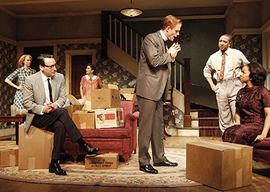
August 31, 2011

In one of Norris’s few long speeches, Lindner explains:
First, one family will leave, then another, and another…and some of us, you see, those who don’t have the opportunity to simply pick up and move at the drop of a hat, then those folks are left holding the bag, and it’s a fairly worthless bag.…
That’s all terribly outmoded and deplorable, but it was also accurate. My late in-laws owned a two-flat in Chicago’s working-class white Austin neighborhood. When middle-class black families much like the Hansberrys started to move in during 1967, their less liberal neighbors told them to Sell Now. They vowed to stay and make integration work. Unfortunately, underclass blacks quickly drove genteel blacks out. After their small children were mugged three times on the street, my in-laws finally fled in 1970, having lost half their house’s net worth.
Hansberry’s Clybourne St. was fictitious, but N. Clybourn Avenue is real. I tried the Clybourn shortcut to the Loop one Sunday afternoon in 1983 but found my progress blocked in the middle of the Cabrini-Green housing project by hundreds of black people excitedly milling about and watching a car burn.
In 1989, my wife and I were warily condo-shopping on North Avenue near Clybourn when a white man approached and told us to Buy Now: The Near North Side land that Cabrini-Green sat upon was too convenient for black welfare mothers to hold for long, he explained. We demurred, asking, “Which alderman will agree to take 13,000 Cabrini-Greeners?”
Steppenwolf, however, was braver. As white-yuppie Chicago’s cultural flagship (I had season tickets from 1987 onward), Steppenwolf’s new theater in 1991, built just north of Cabrini between Halsted and Clybourn, signaled that white gentrifiers would win.
The last Cabrini high-rise was finally demolished this March, the denizens dispatched to the hinterlands clutching Section 8 vouchers. The spot on Clybourn where the car burned is now home to Chicago Fly Fishing Outfitters, serving locals who own second homes in Aspen.
Thus, in Norris’s 2009 second act, an affluent white couple from the suburbs is about to tear down 406 Clybourne St. and rebuild it into a mansion. Then a black couple files suit for historical preservation for “maintaining the integrity…the architectural integrity” of the neighborhood.
The couples and their lawyers meet. Eventually, exasperated white husband Steve, a member of the awkward squad, bursts out, “No, I’m sorry, but can we just come out and say what it is we’re actually…saying instead of doing this elaborate little dance around it?” Of course, that turns out to be a hilariously bad idea.
Remarkably, Norris doesn’t spread any Crash-style balm about how “we just need to communicate,” concluding simply that we are territorial animals.